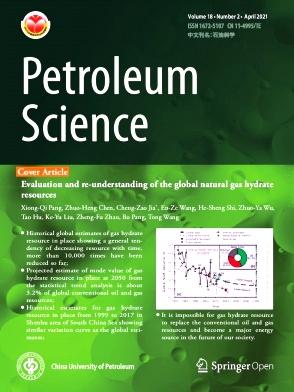采用 LBM-LSM 耦合方案的流固界面波传播
IF 6
1区 工程技术
Q2 ENERGY & FUELS
引用次数: 0
摘要
流固耦合介质中的地震波传播是当前的热门话题。然而,传统的基于波方程的模拟方法必须考虑流固界面的复杂边界条件。为了应对这一挑战,我们提出了一种新颖的数值方案,将晶格玻尔兹曼法(LBM)和晶格弹簧模型(LSM)融为一体。在该方案中,LBM 模拟粘声波在流体区域的传播,LSM 模拟弹性波在固体区域的传播。我们还引入了三种不同的 LBM-LSM 耦合策略,即标准反弹方案、镜面反射方案和混合方案,以描述波在流固边界的传播。为了证明这些 LBM-LSM 耦合方案的准确性,我们模拟了波在包含流固界面的双层模型中的传播。我们分别在流体层和固体层放置激励源,观察地震波从不同侧面传播到界面时的波现象。LBM-LSM 模拟结果与有限差分法(FDM)和解析解(ANA)获得的参考波场进行了比较。我们的 LBM-LSM 耦合方案被证实是有效的,因为 LBM-LSM 解法与参考解法之间的相对误差在可接受的范围内,有时在 1.00% 左右。耦合 LBM-LSM 方案进一步用于模拟更真实的崎岖海底地震波场,揭示了耦合 LBM-LSM 方案在海洋地震成像技术中的潜在应用,如逆时迁移和全波形反演。该方法在模拟复杂的两相和多相介质中的波传播方面也具有潜在的应用价值。本文章由计算机程序翻译,如有差异,请以英文原文为准。
Wave propagation across fluid-solid interfaces with LBM-LSM coupling schemes
Seismic wave propagation in fluid-solid coupled media is currently a popular topic. However, traditional wave equation-based simulation methods have to consider complex boundary conditions at the fluid-solid interface. To address this challenge, we propose a novel numerical scheme that integrates the lattice Boltzmann method (LBM) and lattice spring model (LSM). In this scheme, LBM simulates viscoacoustic wave propagation in the fluid area and LSM simulates elastic wave propagation in the solid area. We also introduce three different LBM-LSM coupling strategies, a standard bounce back scheme, a specular reflection scheme, and a hybrid scheme, to describe wave propagation across fluid-solid boundaries. To demonstrate the accuracy of these LBM-LSM coupling schemes, we simulate wave propagation in a two-layer model containing a fluid-solid interface. We place excitation sources in the fluid layer and the solid layer respectively, to observe the wave phenomena when seismic waves propagate to interface from different sides. The simulated results by LBM-LSM are compared with the reference wavefields obtained by the finite difference method (FDM) and the analytical solution (ANA). Our LBM-LSM coupling scheme was verified effective, as the relative errors between the LBM-LSM solutions and reference solutions were within an acceptable range, sometimes around 1.00%. The coupled LBM-LSM scheme is further used to model seismic wavefields across a more realistic rugged seabed, which reveals the potential applications of the coupled LBM-LSM scheme in marine seismic imaging techniques, such as reverse-time migration and full-waveform inversion. The method also has potential applications in simulating wave propagation in complex two- and multi-phase media.
求助全文
通过发布文献求助,成功后即可免费获取论文全文。
去求助
来源期刊

Petroleum Science
地学-地球化学与地球物理
CiteScore
7.70
自引率
16.10%
发文量
311
审稿时长
63 days
期刊介绍:
Petroleum Science is the only English journal in China on petroleum science and technology that is intended for professionals engaged in petroleum science research and technical applications all over the world, as well as the managerial personnel of oil companies. It covers petroleum geology, petroleum geophysics, petroleum engineering, petrochemistry & chemical engineering, petroleum mechanics, and economic management. It aims to introduce the latest results in oil industry research in China, promote cooperation in petroleum science research between China and the rest of the world, and build a bridge for scientific communication between China and the world.
 求助内容:
求助内容: 应助结果提醒方式:
应助结果提醒方式:


